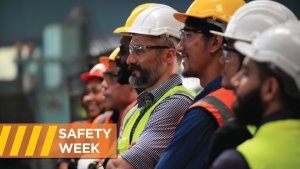The COVID-19 pandemic has impacted us all and has changed the way we act and interact. We employ the hierarchy of controls, social distancing, virtual commuting, physical distancing, increasing sanitization measures, using additional PPE and utilizing face coverings at work and in everyday life.
As leaders, ensuring every worker safely returns home at the end of the day is constantly at the forefront of our minds and takes continued due diligence. Now is the time to develop a suitable plan for your workforce and company to achieve maximum safety awareness, educate and protect against COVID-19 to significantly reduce the number of incidents, accidents and near misses.
Safety Week is an industry-wide event dedicated to educating and increasing awareness in the workplace across Canada and the United States. It provides an opportunity to examine and reinforce your commitment to safety. This commitment is most robust when it is woven into an organization’s culture and is visible in everyday routines, policies and processes.
This year, Ontario will also mark a new day designated to promote safety in the workplace. Bill 152 Occupational Safety and Health Day received Royal Assent on April 27, 2021. The bill proclaims the first Tuesday in May each year as Occupational Safety and Health Day, recognizing the importance of supporting and nurturing a safe and healthy culture in every workplace.
This year it falls on Tuesday, May 4,, so let us all use this day as an opportunity to promote and cross-promote workplace safety and health through education of safety and health rights, responsibilities and prevention measures.
Reinforce the importance and value of safety across your organization and improve your culture by following these five steps:
Commit to safety
Bring the commitment to safety to a personal level by asking company leaders to consider these questions:
How engaged am I in company safety programs? How can I increase my engagement levels with project teams? Can I make a difference in our workers’ safety by engaging more? Does our company empower me to make a difference in workplace safety? How do I influence our company and my leadership?
Ask your leaders to consider these questions and ask them to pledge something new that they believe will make a difference in safety performance and help create an injury-free workplace. Their pledges should become action plans.
If you are a leader in your company, ask yourself: What can I do to be a better leader? What can I do to engage all workers on our project sites and offices? How do I enable others to become leaders and adopt a stronger culture of safety?

Visit project sites and offices
The commitment to safety begins at the highest levels. To showcase that safety promise, executives and management and leaders at every level should make safety-specific video calls and virtual tours of each jobsite and, if possible, in-person visits utilizing physical distancing protocols and proper PPE throughout Safety Week.
Introduce new programs and create remote learning environments. Maximize interactions with the jobsite personnel by meeting (virtually or in-person) with workers and identifying daily workloads, responsibilities and concerns. Following COVID-19 protocols while on location, attend safety-specific meetings and briefings, complete a jobsite safety audit/inspection, engage in safety-specific discussions with forepersons and other crew members. This is also an ideal opportunity to solicit feedback from workers on site conditions, COVID-19 protocols, safety matters and company values. Show visible leadership.
Safety evaluation
Challenge your project teams to confidentially assess where the project measures in terms of safety performance (COVID-19 protocols and measures, non-compliance, compliance, good practice, best in class, etc.).
During the evaluation, focus on safety culture, COVID-19 protocols and education, team member competency/training, communications, best practices, incident reviews, etc., compliance with regulations and subcontractor performance.
If you have not done so already, utilize Safety Week to put additional safety plans into motion and begin or further your efforts to work toward achieving “best in class” status.
At Gillam for example, we are rolling out two new programs aimed at increasing awareness to things on site that are either being done incorrectly or correctly.
They are called “Don’t Walk By” and “Rewarding Good Behaviour.” Trade personnel will also be engaged and participate in this effort as well as they are valued partners and will carry the safety commitment with them into the future.
Hold virtual events and events that focus on safety
Several organizations promote Safety and Health Week, including the North American Occupational Safety and Health (NAOSH) Week and Construction Safety Week. They offer a wide range of ideas for events and activities to hold throughout the first week in May, hosting a virtual safety roadshow and inviting vendors to showcase new tools and safety equipment, holding safety training and education sessions (hand injury prevention, fall protection, ladder safety, etc.). Share photos of weekly activities on social media using hashtags such as #SafetyWeek, #ConstructionSafetyWeek, #SafetyandHealthWeek.
Safety education events are highly productive and beneficial. Safety leaders from across North America share Toolbox Talks, educational materials and best practices. Sharing, yes with your competitors, safety best practices is something that is becoming more widely accepted. Remember, safety is not proprietary.
With COVID-19 protocols in place, it will still be challenging to hold in-person events, contests, lunches, and gatherings; however, we can adapt for May and have another follow-up session in September, providing it is safe to do so.
Conduct virtual training and refresher courses
Safety Week is an opportune time to review policies and procedures on individual jobsites. Here are some activities:
- Hold emergency response drills and mock drills. Invite emergency response teams to come onsite to assess emergency response protocols and procedures.
- Perform a Safety Rollback. Include site housekeeping, cord/tool inspections, rigging inspections and proper storage, assured grounding inspections, PPE inspections, general safety inspections.
- Educate your workers — the theme for Safety Week 2021 is on Fit for Duty and a focus on the four states of Fit for Duty: mental health, physical health, emotional health and competency.
The week will cover all forms of safety and the slogan is “Be Present. Be Focused. Be Safe.” Toolbox talks, educational material and best practices will be shared from safety leaders across North America.
Rob Ellis, president of MySafeWork, often asks, “What do good companies look like? Well, they care for their staff, they care for others, are proactive about safety and lead by example.”
The main objectives for raising the bar for safety in our industry are increasing awareness, promoting education, positive reinforcement, empowering frontline workers, improving cultures and sharing best practices.
These objectives will support our collective efforts to ensure our workforce works safe, new workers are protected and that everyone returns home in the same condition as when they arrived each and every day. Here is what you can do to raise the bar for safety:
- Challenge the status quo.
- Participate in Safety and Health Week 2021 — In May and in September (part two).
- Take part in additional initiatives such as Safety Month (May).
- Leverage safety culture improvement at your company by joining the League of Champions.
- Volunteer to make a difference for safety in our industry.
- Share — after all, safety is not proprietary.
- Make it relatable — use personal reasons to motivate others.
- Winston Churchill said, “Never let a good crisis go to waste,” and we certainly have one with this pandemic. I will add to this something I say all the time; “Leaders need to lead,” and unless we all step up to make a difference, people will continue to get hurt in our industry, which is unacceptable. So, ask yourself, are you a leader?
Craig Lesurf is president of Gillam Group and chairman of the Ontario General Contractors Association Safety Committee. He is also a founder of the Safety League of Champions and its current chairman.











Recent Comments